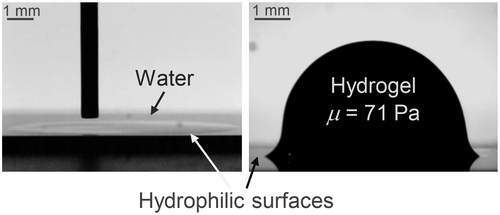Our official English website, www.x-mol.net, welcomes your feedback! (Note: you will need to create a separate account there.)
Elastowetting of Soft Hydrogel Spheres
Langmuir ( IF 3.9 ) Pub Date : 2018-03-13 00:00:00 , DOI: 10.1021/acs.langmuir.8b00368 Aditi Chakrabarti 1 , Amir Porat 2 , Elie Raphaël 2 , Thomas Salez 3, 4 , Manoj K. Chaudhury 1
Langmuir ( IF 3.9 ) Pub Date : 2018-03-13 00:00:00 , DOI: 10.1021/acs.langmuir.8b00368 Aditi Chakrabarti 1 , Amir Porat 2 , Elie Raphaël 2 , Thomas Salez 3, 4 , Manoj K. Chaudhury 1
Affiliation

|
When a soft hydrogel sphere is placed on a rigid hydrophilic substrate, it undergoes arrested spreading by forming an axisymmetric foot near the contact line, while conserving its global spherical shape. In contrast, liquid water (that constitutes greater than 90% of the hydrogel’s volume) spreads into a thin film on the same surface. We study systematically this elastowetting of gel spheres on substrates of different surface energies and find that their contact angle increases as the work of adhesion between the gel and the substrate decreases, as one would observe for drops of pure water—albeit being larger than in the latter case. This difference in the contact angles of gel and water appears to be due to the elastic shear stresses that develop in the gel and oppose its spreading. Indeed, by increasing the elastic modulus of the gel spheres, we find that their contact angle also increases. In addition, the length of the contact foot increases with the work of adhesion and sphere size, while it decreases when the elastic modulus of the gel is increased. We discuss those experimental results in light of a minimal analysis based on energy minimization, volume conservation, and scaling arguments.
中文翻译:

软水凝胶球的弹性化
当将软质水凝胶球放在刚性亲水性基材上时,通过在接触线附近形成轴对称脚,同时保持其整体球形,使其停滞了扩展。相反,液态水(占水凝胶体积的90%以上)在同一表面上扩散成薄膜。我们系统地研究了不同表面能的基质上凝胶球的弹性浸润,发现它们的接触角随着凝胶与基质之间的粘附力的降低而增加,就像人们会观察到的纯水滴一样-尽管比纯净水要大。后一种情况。凝胶与水的接触角的这种差异似乎是由于在凝胶中形成并阻止其扩散的弹性剪切应力引起的。实际上,通过增加凝胶球的弹性模量,我们发现它们的接触角也增加了。另外,接触脚的长度随着粘附力和球体尺寸的增加而增加,而当凝胶的弹性模量增加时则减小。我们根据最小化分析(基于能量最小化,体积守恒和缩放参数)来讨论那些实验结果。
更新日期:2018-03-13
中文翻译:

软水凝胶球的弹性化
当将软质水凝胶球放在刚性亲水性基材上时,通过在接触线附近形成轴对称脚,同时保持其整体球形,使其停滞了扩展。相反,液态水(占水凝胶体积的90%以上)在同一表面上扩散成薄膜。我们系统地研究了不同表面能的基质上凝胶球的弹性浸润,发现它们的接触角随着凝胶与基质之间的粘附力的降低而增加,就像人们会观察到的纯水滴一样-尽管比纯净水要大。后一种情况。凝胶与水的接触角的这种差异似乎是由于在凝胶中形成并阻止其扩散的弹性剪切应力引起的。实际上,通过增加凝胶球的弹性模量,我们发现它们的接触角也增加了。另外,接触脚的长度随着粘附力和球体尺寸的增加而增加,而当凝胶的弹性模量增加时则减小。我们根据最小化分析(基于能量最小化,体积守恒和缩放参数)来讨论那些实验结果。



























 京公网安备 11010802027423号
京公网安备 11010802027423号